#visayan legend
Explore tagged Tumblr posts
Text
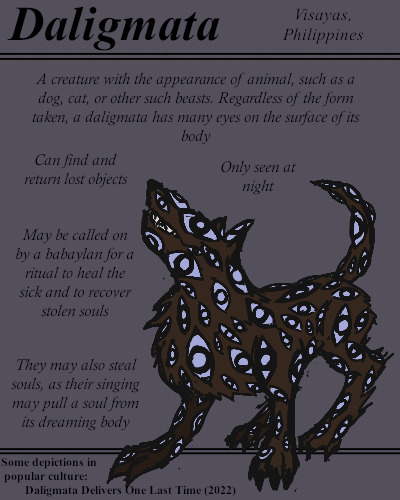
Many-eyed nocturnal beasts. They appear to be primarily benevolent, despite the occasional description of soul-thievery.
#BriefBestiary#bestiary#digital art#fantasy#folklore#legend#daligmata#beast#spirit#soul stealer#filipino folklore#filipino legend#visayas#visayan folklore#visayan legend
26 notes
·
View notes
Note
so i came across yongasabi n thought it sounded similar to tagalog and found myself to be correct. but im not sure how to feel about the explicit usage of bakunawa in yongasabi when it's an irl indigenous mythological creature. now ik youre filipino, so am i. if it were inspired by it instead of straight up using the same name that's fine, but using the exact name is like divorcing it from its origins to call your own, and honestly disrespectful. especially when bakunawa isnt "filipino" but specifically bisayan as opposed to tagalog.
Well if it helps, I'm not just Filipino. My family is Visayan and my family is still there in the Visayas, somewhere in Negros Oriental. Binisaya was actually the first language me and my brother spoke before our parents forced us to forget it and start speaking English instead.
But more than that, I'm not calling the name or legend of Bakunawa my own. I've acknowledged in the document that what I've done with the name and legend of Bakunawa is based on existing myth and isn't my own specifically because I don't want people to think that it's something that I made up. I'm expressly not claiming ownership over it. I want people to read the document, see the name as it is, and know where it comes from. I'm not trying to pretend it's anything else.
24 notes
·
View notes
Text
Pandaguan and the Shark
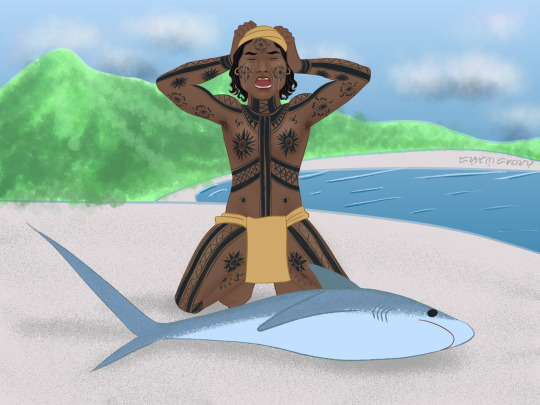
"Once upon a time, people never died. One day, a fisherman named Pandaguan caught a shark, which died. He became distraught and cried loudly in confusion. The god Kaptan became annoyed by his noises and struck him down with lightning. Pandaguan became the first man to ever die."
I first read this story when I was 6. The art is inspired from Adarna Books' illustrated book of the tale. I first drew it for the Legend prompt of Inktober 2019. Pandaguan's clothes and tattoos are copied from an illustration of tattooed Visayan men on the Boxer Codex .
The Aswang Project has used this art for their article on Pandaguan's wife Lubluban. Check it out!
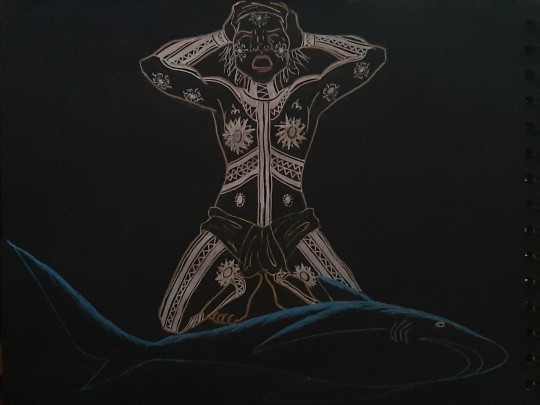
#traditional to digital#digital art#traditional art#black paper#death mention tw#death cw#aeshna's art#philippine mythology#filipino mythology#visayan mythology#pandaguan#death mythology#shark art#alamat#kamatayan
32 notes
·
View notes
Text
bbc ghosts but they’re all Creatures™ from Philippine mythology
*the english translation of the filipino terms are boldly formatted
**i’m not an expert on this area, i just loosely describe and relate the characters based on what i know
**blood, guts, gore, and horror in general ahead, the illustrations are also not mine
• Kitty - diwata or boringkantada or a duwende
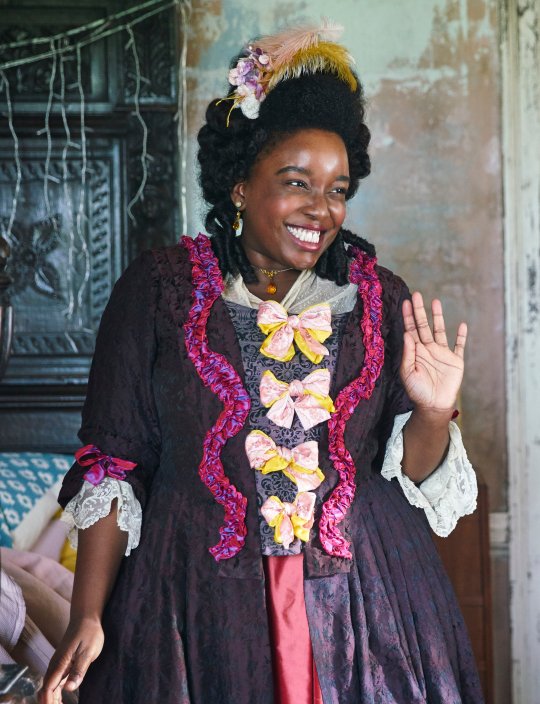

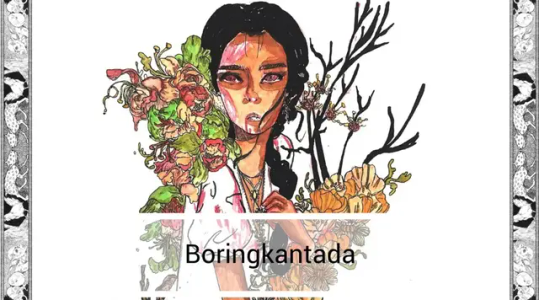
can’t decide which works best for kitty: a filipino nymph, a beautiful supernatural woman or a playful hobgoblin.
diwata is umbrella term for beautiful goddesses, and the most popular ones are dayang makiling, mariang sinukuan, and maria cacao. i think kitty would be mariang sinukuan— a kind and generous goddess who stopped bringing fruits and harvests to humans when they became unsatisfied and greedy.
a boringkantada is definitely not boring: it possesses beauty both physically and in its voice. when someone is lured by its singing, it instinctively assumes the person is about to rob the treasures it guards and viscously attacks them.
the hobgoblin that loves to play, a duwende has the tendency to be extremely jealous and may either shower gifts to the ones they like and play tricks on the ones they don’t.
*i also see pat as a duwende, and i’ll elaborate that on the next parts.
• Fanny - white lady or a dalikamata


i mean, she’s already a grey lady so this one’s not far-fetched. basically, a white lady is a ghost dressed in a white dress, particularly an urban legend that resides in a Balete tree in Quezon City, Manila. it is also known as the Weeping Woman or the Wronged Woman in other beliefs.
alternatively, i also think she would be a dalikamata— a Visayan goddess with many eyes that can see the past, present and the future. i relate the all-seeing, all-knowing attribute to fanny’s nosy attitude.
• Mary - albularyo
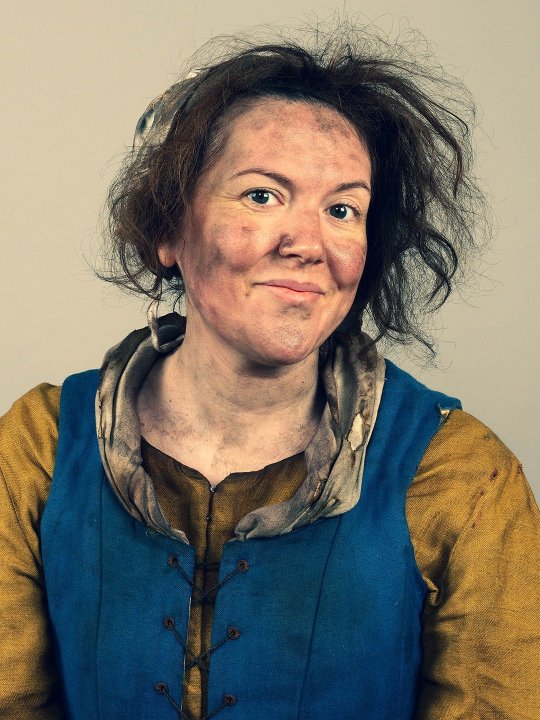

derived from the spanish term herbolario, these folk or witch doctors are either believed to have supernatural abilities to cure illness better than modern medicine or hated for being a pseudoscience and/or a witch. screams mary to me. She knows every herb and ointment, can track the roots of what caused the sickness, but also has the capability to harm those who wronged her. ultimately, she does her best to help others.
• Annie - mangkukulam
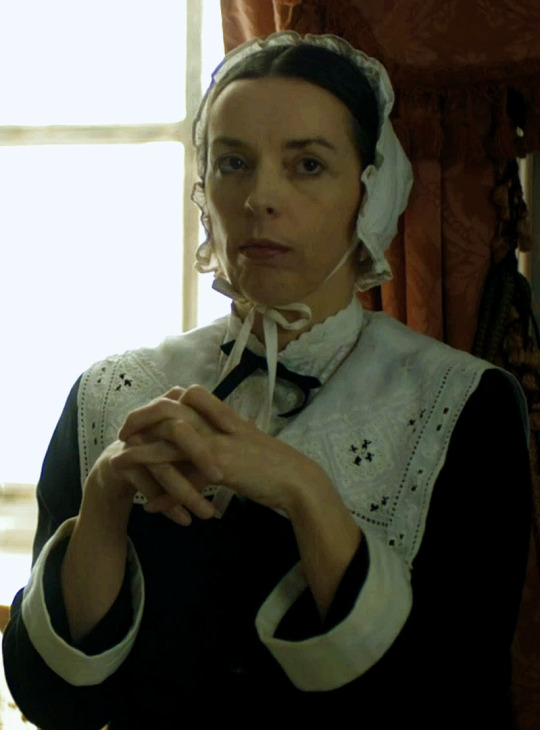

rip annie you would’ve loved putting curses on men. she would’ve been a powerful witch. there are many other terms for filipino witches according to respective regions, but we call them mangkukulam in our area. plus, these witches believe that their spells do not work on the innocent, their targets often being thieves and colonizers.
side note: i actually have this oc from a story i once tried to write wherein the albularyo and mangkukulam are girlfriends because of the contradicting capabilities, and the idiots themselves told me mary and annie were gay.
• Pat - nuno sa punso or a duwende


a nuno sa punso is a dwarf goblin that will harm you if you anger it by kicking its house (an anthill) and/or pissing on it. if modern medicine cannot cure you in any way and you have disrespected him, you may need to ask for his forgiveness or seek help from the albularyo. “tabi-tabi po” or “excuse me please” is a phrase you say to show respect to beings like this.
my first reason for nuno!pat was because of his height. but it is also depicted as a tiny, angry grandpa and a protector of the earth— which reminds me of pat.
on the other hand, the duwende is a hobgoblin that likes playing with children because of its natural playful attitude. this one’s not that easily angered unlike the nuno sa punso, but can still hurt those it doesn’t like.
• Captain - kapre

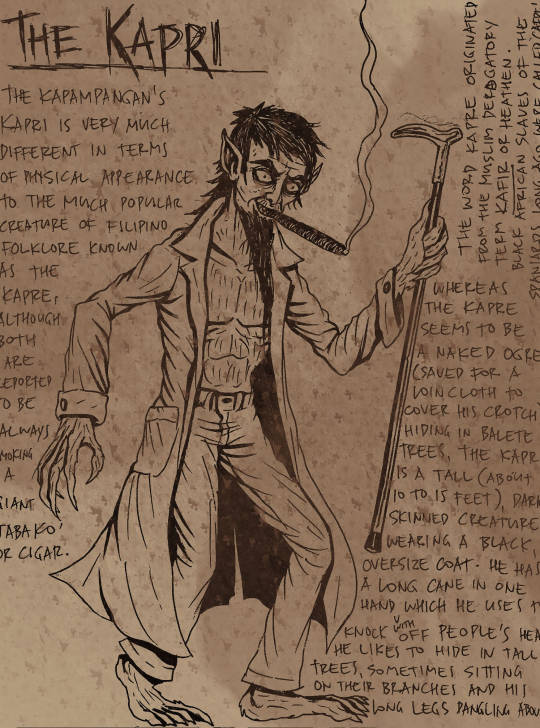
the way i giggled when i thought of cap being a CAPre. kapre cap,,, i feel like the funniest person alive. the photo makes it funnier— just some local kapre with glasses with a tree behind it
a kapre is a cigar-smoking, tree-dweller. traditionally, it presents itself as a hairy, muscular, and tall guardian/protector of the land that can also shapeshift into a beautiful man to invite people to follow them (especially in the woods). hence, it can make you run around in circles as you forget memories of your life.
side note: thomas can also be a kapre because if a kapre likes you, it will follow and protect you from your enemies for life. a former filipino president (emilio aguinaldo) is believed to have outlived his enemies because he had a kapre amulet.
• Humphrey - manananggal or pugot

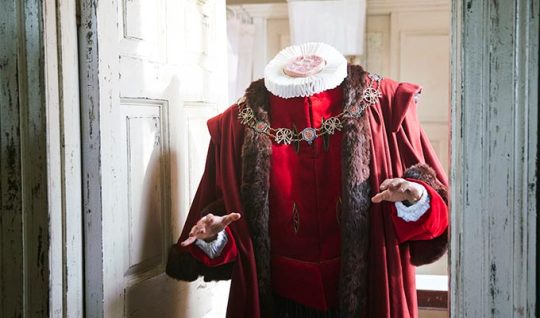

a manananggal is a self-segmenting vampire. its upper torso has wings that help it fly and hunt humans (particularly pregnant women and their babies), while its lower torso stays behind. there is a belief that you can actually kill it by finding its lower torso and putting salt or crushed garlic in it in order to prevent it from uniting with its upper torso. i’m thinking about this image of humphrey’s head having wings attached behind him, and his tudor outfit already spells out vampire to me.
or if we’re gonna be canon compliant, humphrey is already a version of a pugot— a headless creature from the ifugao. but i’m putting this on a maybe part because there are many versions of the pugot: some believe it is a version of the kapre, some believe it is a shapeshifting ghoul.
• Robin - aswang or sigbin or bungisngis
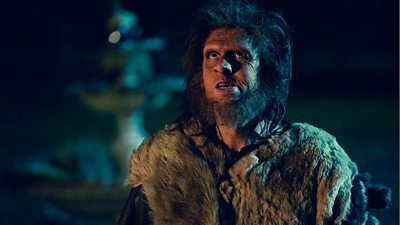
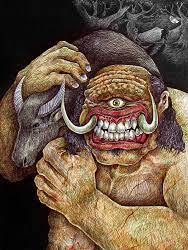

aswang is a broad, umbrella term for all cannibal shapeshifters. they appear as normal humans by day, and various human-animal hybrids by night.
i also see robin as a sigbin. both are seen as dog-like creatures that eat fresh, bloody, and raw meat. some believe that you can keep a sigbin as a pet that will protect you and even let you hop in on its back— but once you let it starve, it will always be a creature of the night that can eat you and your entire family.
robin would also make a good bungisngis because it is a cannibal one-eyed cyclops. its name directly translates to “one who giggles a lot”, which is why it is known for laughing and playing tricks. ironically, it is dumb enough to be tricked.
• Julian - bakunawa or engkanto


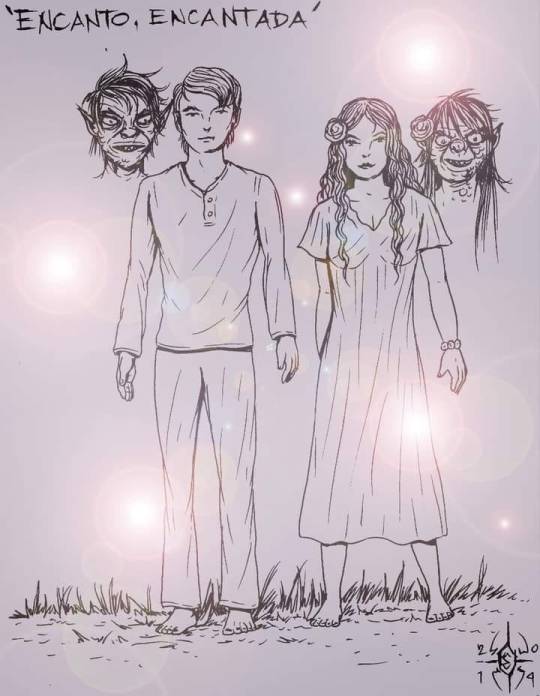
the bakunawa is a dragon serpent notably known for allegedly eating the earth’s seven moons. i’d like to think of that as a parallel to a politician like julian being enamored by the shiny power and wealth.
and because of julian’s charms, he would also be an engkanto— environmental spirits that presents to be good-looking and formerly known as a protector of the people but may also tend to be deceiving (much like of a politician).
• Thomas - tikbalang


this one’s peer-reviewed by a friend so i’m more than confident about thomas being a tikbalang. it appears to be a half-human half-horse creature known to lead travelers astray as they live in the mountains. it is known to be mischievous when it play tricks on humans (a tribute i might also relate to julian or robin), so make sure to wear your shirt inside out or stay quiet while in the woods to not disturb it.
unrelated but fun fact: if it’s raining, we have this belief that a tikbalang is getting married. (this phrase is potentially from the spanish when they believed that a witch is getting married when there’s rain on a sunny day)
#bbc ghosts#button house#six idiots#them there#tw blood#tw body gore#dakotasvibe#userligaya#alison obviously has a third eye#and mike would be the type to be very superstitious#he’d have salt and garlic ready#as you can probably tell#i’m very Normal about this#i’m very tempted to make this a gifset
21 notes
·
View notes
Text
DOKKAEBI, KOREAN GOBLIN
STRAY KIDS “THUNDEROUS” MV THEORY
Dokkaebi are sometimes considered Korean demons or goblins. However, they are also trickster nature spirits with special abilities that allow them to interact with humans. The tricks are largely playful or silly, and sometimes the dokkaebi are also helpful.

Dokkaebi (도깨비) are legendary creatures from korean mythology and folklore.
Dokkaebi, also known as “Korean Goblins”
Dokkaebi are nature deities or spirits possessing extraordinary powers and abilities that are used to interact with humans, at times playing tricks on them and at times helping them.
Legends describe different dokkaebi in many forms, and dokkaebi often wear hanbok.

Dokkaebi are different from ghosts, called Gwisin (귀신) in korean, in that they are not formed by the death of a human being but rather by the spiritual possession of an inanimate object such as old discarded household tools like brooms, or objects stained with human blood.
The physical appearance of the dokkaebi is presented in many different ways and has varied by different time periods but they have always been depicted as fearsome and awe-inspiring.

Different versions of the dokkaebi mythology assign different attributes to them.
Some cases, they are considered harmless but nevertheless mischievous, usually playing pranks on people or challenging wayward travelers to a ssireum (korean wrestling) match for the right to pass.
Dokkaebi are extremely skilled at wrestling and cannot be beaten unless their right side is exploited.
In other tales, dokkaebi only have one leg, so one should hook their leg and push them to win.

Dokkaebi fire is a glimmering light or tall blue flames that herald the appearance of dokkaebi.
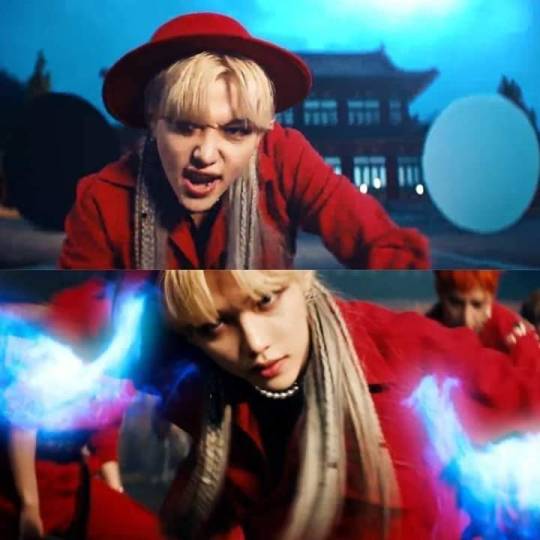
Dokkaebi possess magical items, such as the dokkaebi hat called the Dokkaebi Gamtu (도깨비 감투), which grants the wearer the ability of invisibility and the dokkaebi magic club called the Dokkaebi Bangmangi (도깨비 방망이), which can summon things and act functionally as a magic wand.
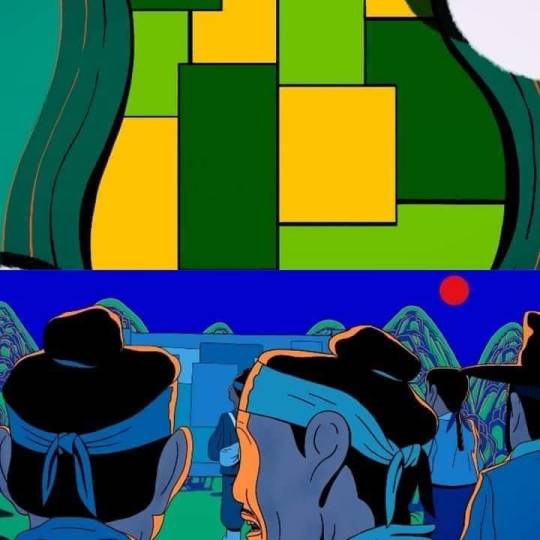
It is believed that dokkaebi have immense supernatural powers, can bring good harvests, big catches and great fortunes to humans, and are defenders against evil spirits.
Depending on the region's traditional folklore, some traditional practices are held to appeal to dokkaebi to bring good luck to humans and other practices are done to chase away dokkaebi, who are thought to be the causes of bad luck that brings fires and contagious diseases.

Although dokkaebis have no actual form, some people divide them into types.
These are some common types:
Cham Dokkaebi (참도깨비) — A mischievous Dokkaebi.
Gae Dokkaebi (개도깨비) — Evil Dokkaebi.
Gim Seobang Dokkaebi (김서방 도깨비) — A dumb Dokkaebi that looks like a farmer.
Nat Dokkaebi (낮도깨비) — Unlike other Dokkaebi, these appear during the daylight.
Go Dokkaebi (고도깨비) — Dokkaebi known to be good at fighting and handling weapons, especially arrows.
Gaksi Dokkaebi (각시도깨비) and Chonggak Dokkaebi (총각도깨비) — Dokkaebi known to attract humans.
Oenun Dokkaebi (외눈도깨비) — One-eyed dokkaebi that eats a lot.
Oedari Dokkaebi (외다리도깨비) — A one-legged dokkaebi that likes to play ssireum (korean wrestling).

In Japanese folklore, Hitodama (人魂) meaning “Human Soul” are balls of fire that mainly float in the middle of the night.
They are said to be “souls of the dead that have separated from their bodies” which is where their name comes from.
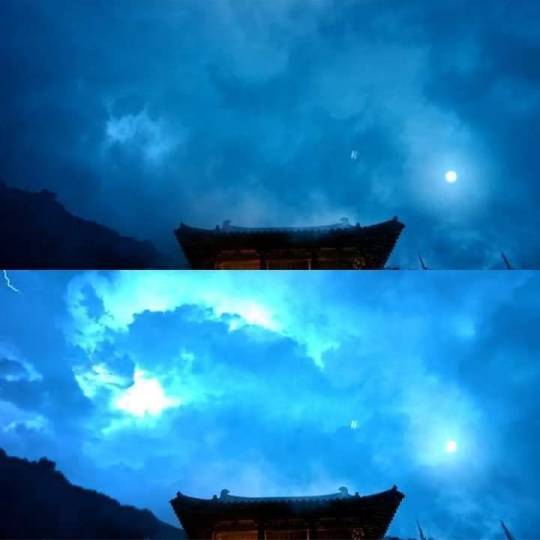
In Philippine folklore and mythology, a Santelmo is a type of fire spirit that mesmerizes humans.
Maximo Ramos describes the Santelmo in his book published in 1990, The Creatures of Midnight.
“Tagalogs, Visayans, and other filipinos call it Santelmo. It is a ball of fire in fields and swamps. It bounces along and rolls away. It changes into a beast with fire in its mouth. Travelers and fishermen follow it at night. They walk and walk till they are tired out then they cannot find their way home. They walk into deep mud and thorny bushes. They get dizzy and become insane. They must reverse their clothes to send it away then they can find their way home.”
The word Santelmo actually comes from “San Telmo” a shortened version of “Apoy ni San Telmo” which refers to St. Elmio fire.
It is a phenomenon that has been witnessed by european sailors for centuries.
St. Elmo’s fire is a mysterious “flame” that often appears atop the masts of ships like streaks of blue light surrounding the pole.
On land, the bright blue flame would appear in canopies or above the trees near rivers, lakes, and other bodies of water.
Generations of sailors refer to the flame as “St. Elmo’s fire” which has been passed to Philippine culture as “Santelmo.”
St. Elmo’s fire is closely associated with thunderstorms. It is usually seen atop poles or trees near bodies of water and looks more like an electric phenomenon. on land, it would appear on bell towers during a storm.
On the other hand, the Philippine Santelmo has a distinct behavior and appearance—it looks like a floating orb usually seen in swamps and fields. It also occurs above the water’s surface and would lure fishermen to their deaths.
Wikipedia
5 notes
·
View notes
Text
The legends depicted in Pedro Monteclaro's book Maragtas have long been a part of Visayan folklore and they are a source of fierce pride for many Visayans today. The stories of the ten datus or cheifs [sic] have been told for generations and they are perfectly believable, as far as legends go, if we put aside the modern additions such as obviously phoney "original" manuscripts and the use of precise but utterly uncorroborated dates from the pre-Hispanic era. After all, it is not hard to believe that exiles could have sailed from Borneo to settle in Panay. Why not? Even though there are no ancient documents to show that Sumakwel and his followers actually existed, there is much archaeological and foreign documentary evidence of regular trade and travel at that time between the Philippines and its neighbours.
Nevertheless, the line between the familiar legends of Maragtas and the hard historical facts was blurred by the misguided nationalism of its author and the blatant dishonesty of other writers. The legends surrounding the famous Datu Kalantiaw, however, were not a part the Maragtas saga. The story of Kalantiaw is more alarming because he was never a part of Philippine history or legend; Kalantiaw was an utter hoax.
2 notes
·
View notes
Text
Siquijor, Philippines: The Hidden Gem of the Visayas
Nestled in the heart of the Visayan region, Siquijor Philippines is a small island known for its stunning beaches, rich culture, and mystical charm. Often overlooked by tourists in favor of its more famous neighbors, Siquijor is the perfect destination for those seeking a peaceful escape filled with natural beauty and local folklore. Whether you’re a beach lover, adventure seeker, or cultural enthusiast, Siquijor offers something truly unique for every traveler.
The Magic of Siquijor: A Land Steeped in Mysticism
Siquijor isn’t just a place of natural beauty; it is a land deeply woven into Filipino mysticism and folklore. The island has long been associated with witches, healers, and magical traditions. Locals speak of potions, charms, and rituals that are said to cure ailments and protect against evil spirits.
While these legends may intrigue some, it’s important to note that the island’s charm lies in its authenticity. The island’s spiritual essence can be felt in the peacefulness of its rural life and in the warmth of its people. Many visitors are drawn not only to Siquijor’s beauty but to the sense of mystery that surrounds it.
Beaches and Waterfalls: The Natural Wonders of Siquijor
If you’re a beach lover, Siquijor Philippines is the ideal destination. The island is blessed with pristine white-sand beaches, crystal-clear waters, and incredible dive spots. Salagdoong Beach is one of the most famous, with its turquoise waters and cliff-jumping opportunities. It’s a perfect spot for those seeking a thrilling yet relaxing beach day.
For those who prefer a more tranquil beach experience, the shores of San Juan and Paliton Beach offer serene sunsets and unspoiled beauty. Beyond the beaches, Siquijor is also home to stunning waterfalls like Cambugahay Falls. This multi-tiered waterfall is a hidden gem, where visitors can swim in natural pools and zipline over the lush jungle landscape.
Cultural Wonders: A Journey Through Siquijor’s History
Beyond its natural beauty, Siquijor Philippines is rich in history and culture. The island’s colonial past is still evident in its architecture, including the iconic St. Francis of Assisi Church. Located in the heart of Siquijor town, this church dates back to the 18th century and is a perfect example of the Spanish influence on the island.
Another significant cultural experience is the Balete Tree, one of the oldest trees in the Philippines, which locals believe is home to spirits. The nearby Fish Spa, where visitors can dip their feet into a pool full of small fish that nibble at dead skin, adds to the mystique of the location. These experiences offer a glimpse into Siquijor’s long-standing traditions and rich cultural heritage.
Exploring Siquijor: Activities and Adventure for Every Traveler
Adventure seekers will find no shortage of activities on the island. Aside from swimming and relaxing at the beaches, Siquijor offers plenty of hiking opportunities. The Mt. Bandilaan National Park is the highest point on the island and provides breathtaking panoramic views of Siquijor and neighboring islands.
For those interested in water sports, Siquijor is an excellent location for snorkeling and scuba diving. The island's underwater ecosystems are teeming with colorful coral reefs, vibrant fish, and even sea turtles. Paliton Beach, for example, is a popular diving spot known for its rich marine life and clear waters.
How to Get to Siquijor: A Traveler’s Guide
Getting to Siquijor Philippines is relatively simple, despite its somewhat remote location. Visitors can fly into Dumaguete, the nearest major city, and take a ferry to Siquijor. The ferry ride is an experience in itself, offering scenic views of the sea and nearby islands.
Once on the island, getting around is easy thanks to a network of motorbikes, tricycles, and rental cars. It’s best to rent a motorbike if you want to explore the island at your own pace. The locals are friendly and will often offer helpful tips on the best places to visit.
Final Thoughts: Siquijor, A Paradise Waiting to Be Discovered
Siquijor Philippines is a place where nature, culture, and mysticism come together in perfect harmony. Whether you’re seeking adventure, relaxation, or a deeper connection with local traditions, Siquijor offers an experience like no other. It’s a place that’s both enchanting and peaceful, making it the perfect destination for anyone looking to escape the hustle and bustle of everyday life.
0 notes
Text
Glazing my art means I have to re-reblog them for this sideblog (sorry, but I'm not taking chances on weirdos using my works to train AI).
As a bonus, I wrote a little more than what I initially had!
(footnotes under cut)
Real ones would notice the changes from the original version. 😂
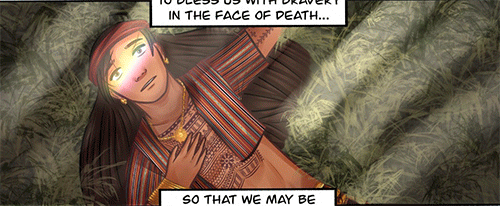
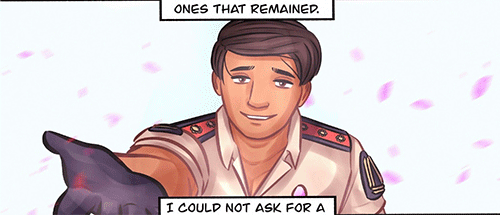

I originally used the precolonial Philippines design by tloraxin. The tattoos were also all Visayan batuk. It was only later on that I really wanted to reflect what shaped his experiences at the time. Part of that desire is also out of spite for popular fanon.
I've talked about his tattoos before. When I have the time again (haha), I will talk about how and why I dressed him up the way I did.
☼ ☼ ☼
The 2nd panel was also supposed to be a bloodier scene. Specifically, Piri was lying dead in a battlefield, surrounded by arms of fallen warriors and their very bodies. He also should have been bruised and concealing a fatal wound through his chest with his hand. Then he is abruptly stirred up by the giant tortoise to cross the rainbow bridge.
I decided to vaguely place him in the afterlife (however that looks), if only because I already depicted him in the midst of war and violence. Not that it's bad to do it again, but I felt like that was enough visual angst from me! 😂💦
Does the comic, in any way, hint that precolonial Philippines died? I dunno, we have a long way to go before I even bother covering that arc. 🤷🏽♀️
I intended for Indo to hold his hand out in that one panel. I hated drawing hands back then (me with feet now). Believe me when I say making pose references and observing where parts go will level up your skill.
☼ ☼ ☼
The last line is so cheesy, even for me, as I look back on it. But it's also an allusion to the challenges in both researching and writing about queer histories.
When I think about that, I cannot help but wonder how people expressed love? How did people define love in the first place? WHAT IS LOVE? BABY DON'T HURT ME!
What more for same-sex love — and by extent, understandings of sexuality, gender, etc.? How were all of these constructed/deconstructed? Transformed/destroyed?
Anyway, I just wanted to draw two queer, brown Southeast Asian men kiss kiss fall in love!
☼ ☼ ☼
This was the original Twitter thread that served as my inspiration. I also attached the respective sources below (in order of the tweets from L to R, top to bottom).


Barton, Roy F., Segundo Aligmayo, Miguel Bacoco, Joseph Biteng, Angel Ayogat, Reynaldo Abad, James Bawayan, et al. “A COLLECTION OF IGOROT LEGENDS: Sagada Social Studies No. 6 (December 1955).” Philippine Sociological Review 22, no. 1/4 (1974): 91–116. https://www.jstor.org/stable/23892245.
Abrigo, Emilia N. "Oriental Mindoro Folktales, An Analysis." Master's thesis, Philippine Women's University, 1971. Quoted in Damiana L. Eugenio, ed. Philippine Folk Literature. Vol. 2, The Myths. Quezon City, Philippines: The University of the Philippines Press, 2018.
Scott, William Henry. Barangay: Sixteenth-Century Philippine Culture and Society. Quezon City, Philippines: Ateneo de Manila University Press, 1994.
de Loarca, Miguel. "Relacion de las Yslas Filipinas," in The Philippine Islands, 1493-1803, Volume V., 1582-1583, ed. Emma Helen Blair. Project Gutenberg, 2005. https://www.gutenberg.org/files/16501/16501-h/16501-h.htm.
Garvan, John M. The Manóbos of Mindanáo: Memoirs of the National Academy of Sciences, Volume XXIII, First Memoir. Washington, 1931; Project Gutenberg, 2006. https://www.gutenberg.org/ebooks/18607.
Disclaimer: These myths were sourced from distinct ethnolinguistic groups that do not necessarily share the same pantheon/s, even if deities and the like have similar names and/or attributes. I combined some of them purely for visual choices.
But also, when you're a lot of things, the afterlife may or may not be as much a funky amalgamation as you are.





PURI v. - to praise n. - to hold pride for
IndoPhil comic I (re)drew for Pride Month 🏳️🌈 I used some rainbow myth stories from across the Philippine archipelago 🇵🇭 as inspiration for this short comic!
14 notes
·
View notes
Text
I am South East Asian and I’m getting tired of people writing away my culture.
I am not sure how many of you know but Disney just released a trailer for the movie “Raya and The Last Dragon” and many people have been taking the moment away from the South-East Asian people (like me) by comparing it to The Last Airbender. Now I’m going to tell you why you should NOT be comparing them.
First, we need to debunk the idea that we can cumulatively call someone “Asian”. That is very much an American concept, a label slapped on our continent to make it easier for them to identify us. However, we have 48/49 countries, with over 1 000 000 languages and cultures. It’s very problematic to pin us down as Asian when we all have distinguishing ethnicities that sets us apart. If anything, certain provinces have similar mythologies, or came from the same previous kingdom, and for that reason it would make more sense if we were identified as North Asia (Siberia), Central Asia (The 'stans), Western Asia (The Middle East or Near East), South Asia (Indian subcontinent), East Asia (Far East), Southeast Asia (East Indies and Indochina). I kind of wish a large number of Americans can see this so they will start calling us by these human geographical groups rather than a continent, and this may dispel the need to compare “Asian” movies.
Now to the comparison of the two movies. The Last Airbender follows East Asian (and some South Asian, New World, Inuit, and Sireniki influences). That is very very different from Raya and The Last Dragon, which completely South-East Asian. Here are some cultural aspects from the trailer:
She uses arnis as a weapon, Arnis is commonly National Martial Arts of the Philippines.
The intro of Disney shows a place in a rock; it represents Sigiriya Rock in Sri Lanka.
When she jumped out of a house, the houses were designed in Thailand's traditional houses.
The Villain's mask is called Barong Mask from Bali, Indonesia.
The Sword of the villain and the sword that Raya pulled are designed from Indonesia's sword.
The wavy sword she's using is a Kris which is a traditional sword in the southern part of the Philippines. So basically her fighting style is Eskrima which is Visayan (central Philippines) but use weapons from Mindanao (southern Philippines)
The whole thing might be inspired by Princess Urduja, the Filipino warrior princess.
The Sea Dragon is from Phillipines and it’s called Bakunawa.
Raya's clothes are Vietnamese traditional clothing.
Her animal that she rides is Khmer name, Thuk Thuk. When u have came to cambodia for 5 years ago and you want to go somewhere, you have to call "Thuk Thuk" and they will ride you anywhere you wanna go.
Theory about the tribes;
the yellow tribe is Indonesian or Malaysian
the purple tribe is Philippine or Malaysian
the green tribe is maybe Thai because of the Elephants or Cambodian because of the advance weaponry
the white tribe is Thai because of the Dholes, clothes, and the sword
Please do not take this moment away from us- South-East Asian culture and mythology has always been written away in South Asian and East Asian dominant movies. Our culture was put into the Legend of Korra and was written off as East Asian and due to this misinformation of cultures, we are now compared to some show that has never represented us. Please stop it. Let us have our moment- though our cultures are mashed together for this South-East Asian adaptation, it retains alot of our key aspects.
South-East Asians are not South Asians or East Asians or Central Asians. We are our own. Let us have that. For once in Hollywood, “Asian rep” is not a Chinese, Japanese, Korean or Indian.
#raya and the last dragon#disney#disney raya#dark academia#movies#south east asia#asia#asian#poc dark academia#poc#hollywood#light academia#representation#poc representation#original post
8K notes
·
View notes
Text
Isles of Bathala: The Aghoy
The Aghoy are small human-like creatures that tend to live in the branches of trees. They tend to have fair skin and vary in the amount of eyes that they have, usually some number between one (1) and three (3). They are considered a cousin to the elves. While they wear clothing made from the surrounding plantlife, they absolutely hate having their feet covered.
When travelers take or damage the trees they call home, the Aghoy will curse them, causing rashes to appear all around the body. In order to remove the curse, you must bring a present to the Aghoy and ask for forgiveness.
Despite this, the Aghoy are always looking for kind and honest people to make friends with. All Aghoy have been blessed with power from the Divinity Anagolay, the goddess of lost things. When they see someone they want to be friends with, they can sense if they have lost something important. Then, they are able to transport the item into their hand to give as a gift to their potential friend.
They also like to play small pranks, such as moving things around when you aren't looking or changing what position you are sleeping in.
The Real Life Inspiration
Much of the description is lifted directly from what I have read of the Aghoy, which is how the East Visayans refer to these small elves. They are described as short, pale-skinned, yellow hair, and bare foot. Most of what I read describes their kindness and search for friends by finding the items that their friends have lost.
The lost item is considered a test in some of the writings. If the recipient of the present acknowledges it was an important item they lost and thank the Aghoy, the person has passed the test of honesty and are rewarded. One item that has come up multiple times that the Aghoy have is magic purse of seemingly infinite gold.
They are also pranksters. They like to live near villages and change the sleeping positions of the people in those villages.
As for when they feel their home is being trespassed, they throw dust into the eyes of the encroachers. This also results in the trespassers developing rashes and twisted lips. This may be remedied by a healer going to the tree of the Aghoy with a gift of rice, asking for forgiveness.
Links
https://www.aswangproject.com/creatures-mythical-beings-philippine-folklore-mythology/
https://mythmuseum.weebly.com/aghoy.html
https://www.philstar.com/the-freeman/cebu-lifestyle/2015/10/30/1516860/creatures-filipino-myths-and-legends
https://mythus.fandom.com/wiki/Aghoy#:~:text=In%20Philippine%20Mythology%2C%20the%20Aghoy%20are%20small%20humanoids,enter%20a%20friend%E2%80%99s%20house%20if%20they%20are%20invited.
https://www.aswangproject.com/the-elves-of-philippine-folklore/
#dnd#dnd homebrew#dungeons and dragons#dungeons and dragons homebrew#ttrpg#indie ttrpg#ttrpg homebrew#filipino#filipinx#philippine#filipino myth#filipino mythology#philippine myth#philippine mythology#aghoy#isles of bathala#filipino american
14 notes
·
View notes
Photo
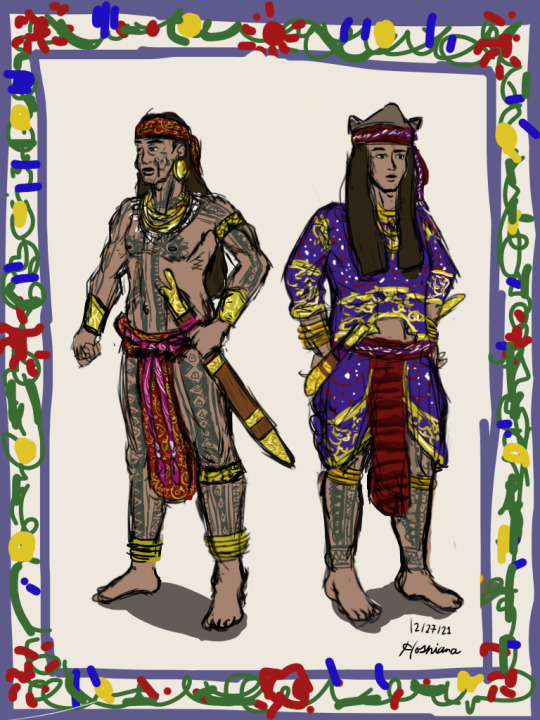
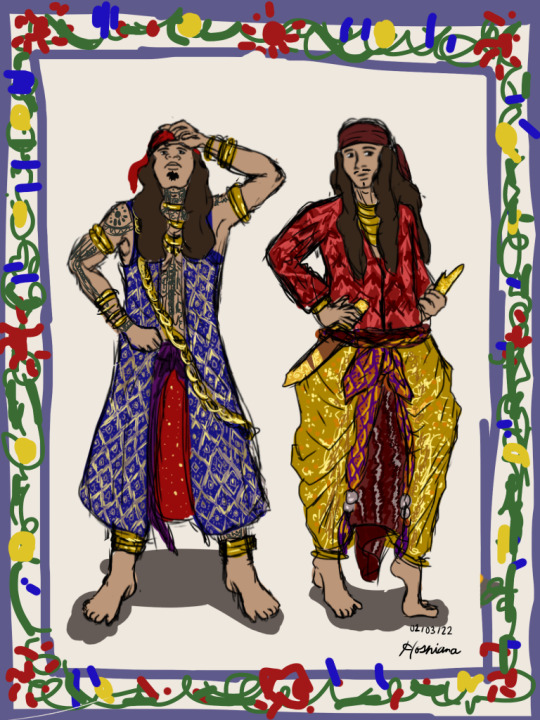
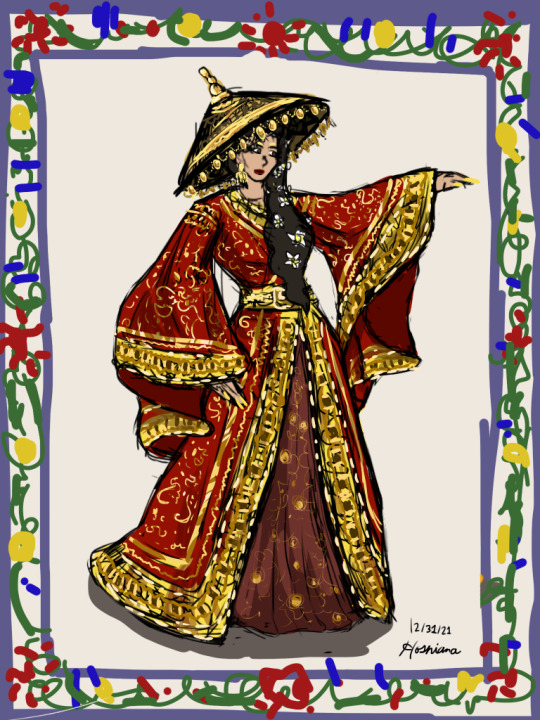
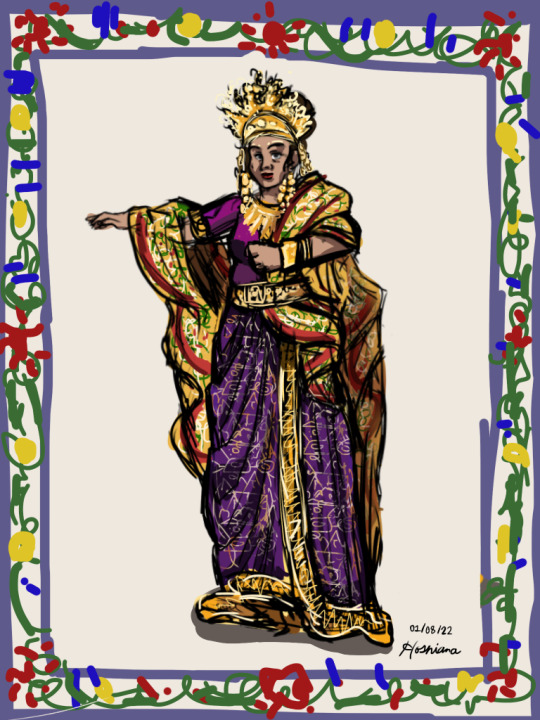
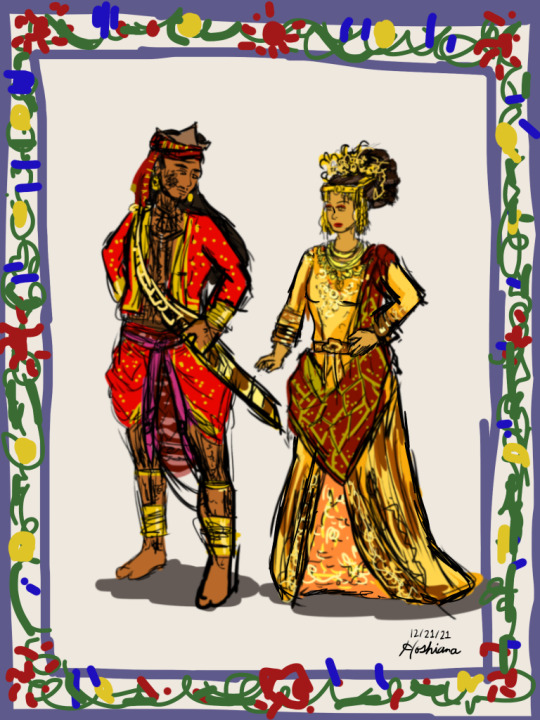
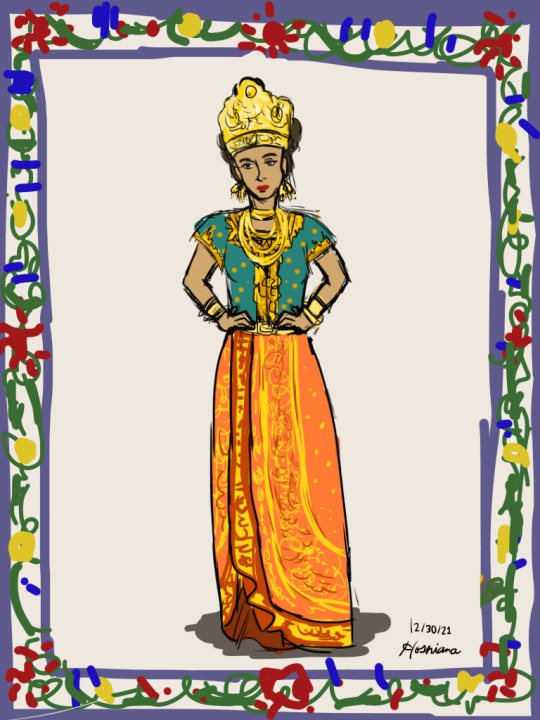
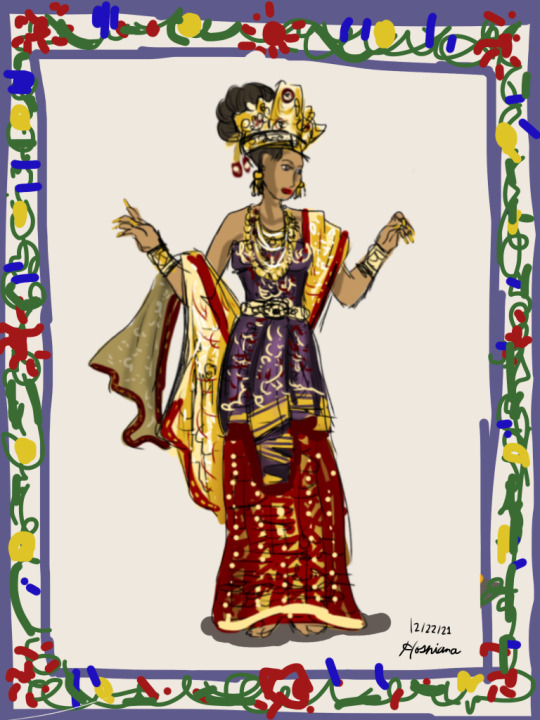
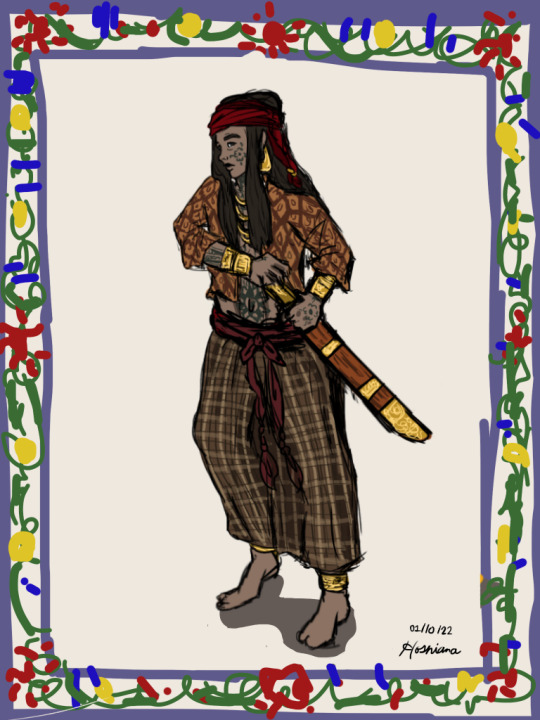
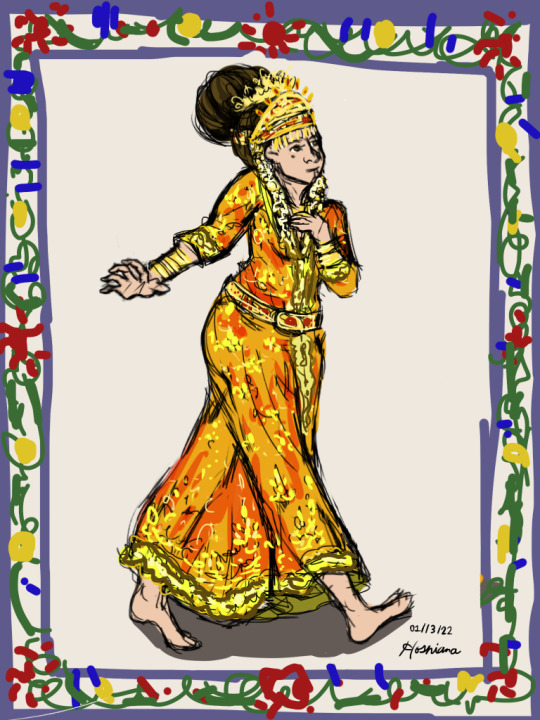
FINALLY! I'M BACK!
I was inactive for about 2 months due to the tons of projects and assignments that I needed to comply with and, most of all, the Typhoon Odette (Typhoon Rai) and our electricity and internet have fully restored earlier this month.
So here are the character designs of my upcoming comic "Ang Timbangan Sa Daragangan" ("The Scale of A Hero"), formally known as "The Legend of Bolo". Most of these designs are created when we had no electricity and internet, so it was quite challenging.
UPDATES OF MY UPCOMING COMIC:
1.) I was able to finish the first draft of my comic, so I now proceed to Scriptwriting, which serves as my second draft.
2.) I changed the title from "The Legend of Bolo" to "Ang Timbangan Sa Daragangan" because it fits the theme of my story.
3.) I'm currently doing note-taking of the different cultures, customs, beliefs, and social classes of the Pre-Colonial Visayas as well as the different gods and goddesses in Visayan Mythology.
Drawn using fingers on my iPad mini through iBisPaint X App.
#oc#illustration#precolonial#philippines#digital art#digital sketch#digital drawing#digital painting#ibispaint art#ibispaintdrawing#characters#character design#concept arts
11 notes
·
View notes
Text
Manananggal
The Manananggal is hideous, scary, (usually) female, and it is also capable of severing its upper torso and sprouting huge bat-like wings to fly into the night in search of its victims. The name comes from the Tagalog word tanggal (cognate of Malay tanggal), which means "to remove" or "to separate", which literally translates as "remover" or "separator". In this case, "one who separates itself". The name also originates from an expression used for a severed torso.
It is said that they mostly prey on sleeping, pregnant women, using an elongated proboscis-like tongue to suck the hearts of fetuses, or the blood of someone who is sleeping. The severed lower torso is left standing, and it is said to be the more vulnerable of the two halves. Sprinkling salt or smearing crushed garlic or ash on top of the standing torso is fatal to the creature. The upper torso then would not be able to rejoin itself and will die by sunrise. It is known to hide in volcanic caves by day.
The Manananggal shares some features with the vampire of balkan folklore, such as its dislike of garlic, and vulnerability to sunlight.
The legend of the Manananggal is popular in the Visayan region of the Philippines, especially in the western provinces of Capiz, Iloilo, and Antique. There are varying accounts of the features of a Manananggal. Like vampires, Visayan folklore creatures, and aswangs, Manananggals are also said to abhor garlic and salt. They were also known to avoid daggers, light, vinegar, spices and the tail of a stingray, which can be fashioned as a whip. Folklore of similar creatures can be found in the neighboring nations of Indonesia and Malaysia. The province of Capiz is the subject or focus of many Manananggal stories, as with the stories of other types of mythical creatures, such as ghosts, goblins, ghouls and aswangs. Sightings are purported here, and certain local folk are said to believe in their existence despite modernization.
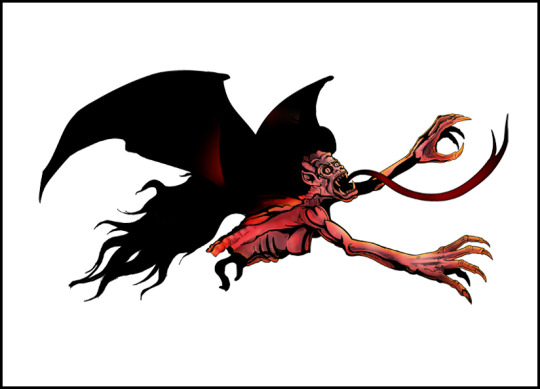
Pic by bobbybarredo on DeviantArt
17 notes
·
View notes
Note
Thank you so much, I learn a lot of mystical creatures because of you, anyway do you know any Filipino mystical creatures I would really appreciate it
Thank you!
There are actually a lot of myths from the Philippines about strange creatures and spirits that dwell in the deep forests. The Tikbalang is one of the better known ones: it's an evil creature associated with horses. In modern images, it's sometimes depicted as a monstrous horse, and sometimes as a humanoid creatures with horse-like features such as a horse head, tail or hooves. In folktales, it usually takes the form of a humanoid with a horse head and (often) very long arms. Note that this creature was originally a kind of forest ghost or tree spirit, and it wasn't associated with horses (horses aren't native to the Philippines after all) until horses were introduced by colonists and settlers.
There is also the Aswang: a ghoul-like undead monster that eats corpses and people. They can supposedly shape-shift into large, black dogs. In modern times, they are often associated with vampires. In some (I think modern?) tales, they are said to kill pregnant women to feast on their unborn babies.
Rupert Gould, a 20th century author who was fascinated by cryptozoology and supposed paranormal sightings, also wrote about a creature called the Berbalang: vaguely humanoid monsters with cat-like eyes and bat-like wings. They can enter a sort of trance which lets their spirit roam free. The spirit can then enter a human body and devour its organs, killing the victim on the spot. It is said that these monsters can be warded off with coconut pearls (those do not actually exist, but in the 20th century there was an urban legend or hoax where people claimed that coconuts could produce rare and precious pearls, much like oysters).
I also have a handful of posts about creatures from the Philippines:
There is the Batibat (evil tree spirits): https://bestiarium.tumblr.com/post/661847418072072192/the-batibat-filippino-mythology-ilocano
The Amalanhig (undead monsters from Visayan folktales):https://bestiarium.tumblr.com/post/662935381007876096/the-amalanhig-philippine-mythology-in-philippine
The Tiyanak (fiends that take the form of infants):https://bestiarium.tumblr.com/post/657689570363703296/the-tiyanak-philippine-mythology-should-you-ever
And the Manananggal: https://bestiarium.tumblr.com/post/667740779580702720/the-manananggal-philippine-mythology-the
14 notes
·
View notes
Text
Craig of the Creek got Filipino rep before we got a Filipino Legend
Hell yeah! I rarely see Visayan rep when it comes to Filipinos being depicted in international media
9 notes
·
View notes
Text
World Religion Resources (Part 6)
Aztec, Mayan, and Incan:
Aztec Religion
Aztec Hymns
Mythology
Mayan Texts
Inca Myths
Aztec Gods
Aztec Folklore and Magic
Aztec Creation Myth
Aztec Gods and Mythology
Quetzalcoatl
The Myths and Worship of Quetzalcoatl
Coatlicue
Xochiquetzal
Itzpapalotl
List of Major Mayan Deities
Mayan Symbols and Meanings
Inca Gods
Inca Deities
Native American:
Native American Culture
Mythology
Myths and Legends
Mythology
Trickster Tales
Chinook Legends and Myths
Cherokee Myths
Navajo Myths and Prayers
Myths of the Plains Tribes
Hopi Myths
Angwusnasomtaka, the Crow Mother
Gendenwitha
Deity List
Native American Spirituality (Video)
Australian Aboriginal:
Aboriginal Religion
The Dreamtime
Mythology
Mythology and Traditions
Wandjina
Filipino:
Philippine Deities
Ancient Visayan Deities
Filipino Deities
Myths and Folklore
Mythology
Mythology and Folklore
Compendium of Filipino Folklore Creatures
Maori:
Maori Gods and Beliefs
Maori Deities
Creation Myth
How Maui Brought Fire to the World
The Unseen
Whaitere, the Enchanted Stingray
Kawariki and the Shark Man
Hawaiian:
Hawaiian Religion
Creation Myth
Deities
Goddesses
Mythology
Book on Hawaiian Mythology
Pele Myths
Part 1 | Part 2 | Part 3 | Part 4 | Part 5
#world religions#spirituality#aztec polytheism#mayan polytheism#aztec#mayan#incan#native american#native american religions#aboriginal#filipino religion#filipino polytheism#maori#hawaiian#oceanic religions
270 notes
·
View notes
Text
They Called Him Death
=== + ===
@raichoose in relation to that one ask.
Characters
Sidapa – He is known as the Visayan God of Death. Once also considered a god of the skies, Sidapa descended from the Heavens and instead made residence atop Mt. Madjaas. Here, he carries out his job of overseeing the existence of men. On his tree, he carves lines that signify a human’s lifespan. He is also in love with the seven moons that are up in heaven.
Bulan – He is the youngest of the seven moons and is the consort of Sidapa.
Hangin – A Diwata or Fairy of the Wind. Her name “Hangin” literally means wind.
Mermaids/Sirens – They are water spirits that possess an upper body that resembles that of a human girl or woman while their lower halves resemble fish tails. Apart from being beautiful, they have enchanting voices which they use for singing.
Saragnayan – He is known as the Visayan God of Darkness. He is considered as the god whom the evil creatures of the night obey as their leader. He is also known to cause chaos in a peaceful community. Saragnayan is said to be a superb spell caster who can control malevolent spirits and that he causes men to do evil things. Despite this, he is a very loving and loyal husband to his wife.
Luyong Baybay – She is known as the Goddess of the Tides. It is said that she is the one who controls the rising and falling of the tide. Luyong Baybay is also in love with the moon.
Kaptan/Makaptan – He is the Visayan Sky God and is considered to be the King among all of the Gods. In myth, he is said to be the equal of Kan-Laon. His stature reminds the Visayans of a proud Datu and he is very protective of his domain. He also has a fiery temper and is easily displeased when people worship other gods or idols before him.
Bakunawa – The Bakunawa is considered to be a creature that resembles either a sea serpent or a dragon. In most legends, he is in love with the moon. He finds them so beautiful that he eats them.
Nagmalitong Yawa Sinagmaling Diwata – She is the wife of Saragnayan.
Kan-Laon – He is, among the Visayans, known as the Supreme Deity. Unlike Kaptan, he is a kind and gentle God who chose to live in solitude in a magical hut that is located at the top of the Kan-Laon Volcano.
Minokawa – The Minokawa bird is considered to be a creature that belongs to a family of dragons. It is also a creature that eats the moon and could possibly eat the sun too. The Minokawa’s feathers are as sharp as blades, his beak and claws are made of steal and his eyes of glass/mirrors.
Kataw – The Kataw are mermen of the highest rank and the rulers of the ocean. They resemble humans almost completely except for the fact that they gills and they have fins on their arms. Unlike the mermaids, they don’t have tails but instead have feet. They have the capability/skills to manipulate water.
***
They called him death, yet all I could see from him was life.
Love is perhaps the most curious of things, vaguest of concepts and the sweetest of thoughts. It is probably the only thing that moves the cog wheels of one’s heart no matter how much time and feeling has been eroded by both emotions and senses. It is truly a most beautiful thing that gives a sense of completion to those who feels it.
Yet it is also wicked despite its splendor. How many have lost their lives for love? How many had been driven mad by the very notion of it? There are those who were forced into silent desperation, always longing and always wanting. Those who yearn for love were always in the company of despair and insecurity. There is always a certain fear that lingered in their hearts one which, when realized, could make even the strongest of those beyond or beneath Heaven and Earth break and crumble.
Oh, what fragile creatures are those who are in love; hearts became malleable despite possessing a spirit of insurmountable will.
Though perhaps that is the beauty of it all; despite the consequences of taking a road led by love, almost everyone still threads it. While hesitant, those influenced by it allowed themselves to be enraptured by it as they miraculously find comfort in their strange actions. Regret hardly exists if the sensation is real. It is a cause that unites not only the mind and body, but also both heart and soul.
Love is indeed, despite its pristine magnificence, a terrifying thing for love is the only pain that humanity gladly embraces.
Of course, Love was never exclusive to humanity. Before them or more appropriately, like them, even those within the seat of divinity also fell prey to this beautiful monster’s embrace.
***
“Bulan! Bulan! Let’s play, let’s play!” A choir of melodic voices called to a passing young man.
A smile was easily painted on his face when he heard and saw them.
Oh how gorgeous they were, the inhabitants of the lake hidden within Mt. Madjaas. A myriad of beauty paraded themselves along the water’s edge. Their iridescent fins under the light of the sun were truly the embodiment of magnificence. These fantastical creatures often did not come out during the day but whenever he came to pass this heavenly retreat, they were always there. They were always waiting with vigorous eagerness. They were wonderful...as wonderful as their peerless hymns.
“Oh...!”
“Oh”
“Oh...” A unison of murmurs resounded. Even those seemed like a song. Their gentle voices coupled with the sound of splashing water made them appear shyer than their normally playful selves. There was of course only one reason for this.
Ah, they must be the younger mermaids. Bulan thought.
Along with the boy was a rather dreaded existence, or so thought the blooming sirens. With him was Sidapa—The God of Death and ironically the ruler of a place that flourished with life, Mt. Madjaas.
Sidapa was a handsome man, and in Bulan’s eyes did not pale in comparison with the other spirits or deities that lived amongst them. His skin was as pale as the ash that had fallen from freshly burned wood. His raven colored hair was as dark as the night, but was as soft as the light of day. Though his countenance was stern in nature, he was quite a gentle god. More than anyone he understood the value of life because he was the one who marked its end. It was a little sad that humanity, along with some of the inhabitants of his own abode, saw him only as a monster.
Though according to the God of Death, none of this mattered so long as Bulan himself didn’t believe it to be so.
And Bulan never did share the majority’s sentiments. Along with the others who had seen the softer side of Sidapa’s nature, he understood that he was not someone who deserved the reputation that preceded him.
“Sidapa,” Bulan called. There was an almost childish gleam of playfulness on the boy’s face that made the temperamental god loft a brow out of curiosity.
“What is it?” He demanded.
“Can I go and play with the sirens?” The boy asked.
How could he say no to that face? Bulan had the exuberance that could be matched by no one. Such a pure boy he was that Sidapa was rendered helpless to the child’s innocent whims. How hard it was for him to say yes…ah, he wanted to greedily keep the boy for himself because they did not always have the leisure to stroll around like this.
What was harder to do though was deny Bulan of his request. Ever since the boy arrived, he had never made any selfish claims (If wanting to get to know him could even be considered selfish) and instead willingly followed whatever it was that Sidapa himself wanted.
Of all the days the mermaids had to come out, it really HAD to be today. This was giving him a headache.
"I can't?" Bulan asked once again.
The Lord of the Mountain groaned his approval. "Do as you please."
Overjoyed, Bulan wrapped his arms around Sidapa briefly before joining the mermaids by the lake. The boy's kind gesture caused the god to freeze momentarily. Even up till now he still could not get used to feeling another person's touch. He was, after all, death incarnate. Whatever he touched was forced to draw their last breath and it frightened him that one day he would accidentally steal the boy's.
But Bulan had been patient, and had ask to be taught a workaround for the curse. Now, even he could hold hands with the boy without it being fatal.
He smiled to himself discretely. Bulan was such an enchanting existence.
Leaving the child to his devices, the Death God went ahead and took his rest under a tree whose shade extended over to the waters. From there, he watched his consort associate with the playful water sprites.
Oh how bittersweet it was to see his lovely Bulan smiling while he was not by his side.
…A dreaded reminder that he could be perfectly happy without him.
“Bulan sure has grown.” Said a voice.
“Shouldn’t you be guarding the forest, Hangin?” Sidapa said without even sparing a glace to show his evident distaste for the unwelcomed intruder.
“You shouldn’t be so grumpy since you’re watching over the boy Moon, Lord Sidapa.” Hangin said. The god simply quirked a brow before facing her; she was at it again with her witty but unnecessary comments.
Hangin was one of the Diwatas of the Wind (Wind Faeries) that resided within the expanse of the mountain. Though the Fae was quick-witted and wise, he often overlooked this due to how mischievous and playful a sprite she could be. Despite such, he still considered Hangin one of his more trusted confidants as she was both a friend that he had learned to accept and a guardian to whom he had entrusted his forest. The wind fairy initially insisted upon this for being allowed to make Mt. Madjaas her home.
“Look, Bulan’s waving over here!” She said.
In an instant Sidapa’s attention fled the mischievous nymph only to find that his dear Bulan was still busy fraternizing with the sirenas.
“Made you look, tee he he!” Hangin teased.
“As always, your jokes are distasteful.” He snarled. “Though I suppose it matters not,” He said, continuously gazing at the boy. “You are correct, however; he has grown quite a bit hasn’t he?”
“He has. The first time he came here, he was barely taller than me. And now look at him; the sirenas are enamored by his presence.” She agreed.
“MUST you point it out? Look at how annoyingly they fawn over him.” He still couldn’t believe they stole Bulan away from him just like that. Willing the thought away, he instead focused on Hangin’s sentiments. “The first time that he came here, how long has that been now…?” Sidapa’s voice trailed off when he decided to lean back and close his eyes. He reminisced that time, that turning point in his life when he had been saved by this unsung hero of his existence.
Bulan’s descent from Heaven was the pinnacle of Sidapa’s happiness.
***
Ah, how beautiful they are…
Atop the mountain and under the comfort of his tree, the God of Death looked up at the sky and watched as the seven moons danced amidst themselves in a sea of stars. To him, they were far more radiant than the sun. Their brightness did not outshine one another as they illuminated the gloomy veil of night.
Night time was Sidapa’s favorite part of the day because of this. It was only during these few hours that he could revel in the grace and elegance of these celestial bodies. He often would think that they danced just for him…a silly delusion, but that alone brought solace to the life of solitude that he had chosen. Seeing the seven moons play amongst themselves made it a little easier for him to continue his work. He was the one who oversaw the end of things— the end of life, surely no job was more depressing than his. A night like this up in his mountain was his only saving grace, a reverie that he chose to drown in for even just a while.
And he was content. To look at them from afar was enough. He dared not to covet the moons that he loved so much for his touch was the very kiss of the end itself. Ironic how despite being a god he was cursed by the very thing that he was; all he did was take and take and take…he could not even begin to imagine the horrors he would feel if he caused one of the moons to draw their last breath.
He was like a madman in his desire for them, wanting them for his own, only to keep holding himself back because that was how it should be. A sentiment kept for the sake of those that he held dear.
“If you don’t act soon someone else might steal those precious moons that you love so much.”
“Saragnayan, who allowed you to step foot on MY mountain?” He didn’t even need to take a look to know who had arrived. And of all those that could, it really had to be another who was as vile as he was; maybe even more.
“Is that how you treat your friend?” Saragnayan scoffed.
“Go back to Gadlum, I don’t need you causing trouble here, again.” Sidapa ordered, whisking the other away from whence he came.
“You can’t still be mad about that, it was just a joke.” Said the accused instigator of chaos.
Sidapa should learn to take a joke or better yet get used to what it is that I do. Saragnayan was the God of Darkness and Sidapa of all people should know the kind of things that he enjoyed. So, he may have manipulated some of the people who got lost along the steep trails of Madjaas; and he may have influenced them to set a few things on fire…but it was all in good clean fun…for the chaotic god at least.
“A joke?” That sent Sidapa’s senses ablaze. “A JOKE, SARAGNAYAN? LEAVE. Leave now before I carve whatever life you have left onto this tree!” Came the god’s outburst as he stood from his place, marching over to his unwelcomed guest.
How could he see something like that as a joke? The creatures under his protection almost lost a home along with their lives due to the mischief that the distasteful god created. While the animals on his mountain were unharmed, the same could not be said for the forest itself. Had he been slower, his home would have probably burned to the ground. How could Saragnayan even think of doing such a thing when he himself, from time to time, gathered flowers for his beloved wife from the flora and fauna of Madjaas.
He considered him his friend on some occasions, on others; he was the type of companion that needed a proper beating.
“And you’re just a stick in the mud.” The other taunted further.
“Get off of my mountain unless you want me to k—!”
“Fine, I shall take my leave. It IS clear that you are not interested in Luyong Baybay’s attempts to coerce the moons to descend from Heaven.” Saragnayan didn’t even give the Death God a chance to finish his rant.
This was the part that he loved the most. Sidapa’s expression drastically changed. His already pale face was getting whiter and his body quivered; practically shook from the news! Saragnayan knew of his friend’s infatuation with the dancing beauties that illuminated the night sky and often saw him gazing at them longingly; lovingly as if a child possessed. How could he not share this little piece of information to him? The deity had every right to know, every right to feel agonized and had every right to act upon his desires. For him, that was how gods like them should act.
“What has Luyong Baybay been up to?” Finally, the silence was once again broken.
“NOW you want to know?” Saragnayan goaded.
“Just say it.” He answered, an apparent jealousy beginning to seethe through his voice.
“She has been singing to them.”
"Singing?" Death repeated. The building frustration he felt simmered and was slowly replaced with curiosity instead.
He had noticed it lately. Was Luyong Baybay’s song the reason for this? Was it her singing that made those seven heavenly creatures more joyous during their nightly affairs? Were they happy because they were fond of the singing...
...They were happy because of Luyong Baybay?
“Sidapa, are you alright?” Asked Darkness.
The Death God couldn’t have been in a more murderous state than he was right now. Even Saragnayan felt the ominous intent emanated by the other. He could not blame Sidapa because more than anyone, he knew every nook and cranny of this thing called love. After all, Saragnayan had himself a beautiful wife that was sought after by most. Of course, no other fate befell those heathens other than death. Their efforts though were valiant and commendable...foolish, but commendable indeed.
This was how he knew of feats that were fueled by jealousy.
Envious men were dangerous since they exhausted everything for the sake of obtaining what they want. They were desperate enough to cross the threshold of madness.
And looking at Sidapa now, he was envy personified.
Saragnayan had to admit that he liked it this way. By being in the midst of anger, he could compel Sidapa to his will. For an alleged God of Death, he always viewed the other as somewhat soft and sentimental. It was unbecoming of his post and surely needed a little push in the direction of chaos. What better opportunity than now, right? Now that Death was green with envy, the God of Darkness was all the more compelled to sow and nurture seeds of discord.
“Saragnayan,”
Or perhaps he didn’t need to do anything more. That odious glimmer in Death’s eyes said it all.
“I hope you told your wife that you’ll be gone for quite some time. You’re not leaving until I drive that harlot Luyong Baybay to her knees.” Sidapa informed his guest.
“My darling is an understanding woman, I’m sure that she’ll—wait…what?” And here he was about to boast about the good qualities of his beloved only to realize that he had been dragged into something that he initially only wished to see…not participate in.
“This is me cutting you some slack for almost destroying Madjaas, Saragnayan.”
“But…but my wife!” He protested.
“Your wife can wait.” Sidapa replied coldly.
***
“Ahaha!” Hangin laughed. “I’m sorry Lord Sidapa. I really just can’t see Master Saragnayan allowing himself to be dragged around like that.”
“You’re right in thinking so.” He chuckled, remembering how valiantly the god tried to escape again and again as he declared disinterest in participating in the little revenge plot.
Saragnayan deserved whatever it was that the God of Death had pitted him with. Besides, he was also the one who told him of Luyong Baybay’s infatuation with the moons.
“No need to feel anything for that one. Whatever misfortune that befell him was of his own doing.” He said, actually quite pleased for once. Just remembering how Saragnayan endured those countless nights at sea without as much as a word from his other half was a spectacle.
“But what happened to Luyong Baybay?” Hangin asked curiously.
“I tortured her, of course.” He answered, an air of indifference suddenly hanging over his features.
“You would torture someone merely for singing to the moon?” She asked again.
“Yes.” He confessed.
“Was it even Bulan that she sang to?” Hangin questioned further.
“At that time I did not care which of the seven moons she sang for. I loved them all, you see.” Sidapa chuckled.
Now that he thought about it, perhaps he had been too drastic in his approach.
If he cared to try hard enough, Sidapa could still hear the agonized screams of the Goddess of the Tides, Luyong Baybay. The Death God kept her confined in a veil of darkness, away from the prying eyes of those who held her sacred. There, in Saragnayan’s domain, the goddess was bound and shackled by shadows that slowly ate away from the knee down. Her shrieking was like music, while the curses that spilled from her shaking mouth were not unlike the sweetest of delicacies. To see her desperation was enough. A quick death was not something that the deity of the tides deserved. Sidapa had no intentions of ending her. What he wanted was to watch her suffer.
“Lord Sidapa?” Hangin called out, putting an end to his bittersweet memory.
“Tell me, Hangin.” He started. “If someone threatened to steal away that one thing you loved and cherished, would you not entertain thoughts of cruelty against your rival?”
The wind fairy thought about this for a while. As someone who had not experienced the same feelings as her lord, she could not tell. She was a simple free spirited sprite and cared only for what she wanted to care about. For now, the only real thing she saw as important was Mt. Madjaas itself, her home. Without it, where would she be? If it wasn’t for this place, Hangin may still have been wandering the land. She might have simply left her fate to the unforgiving winds that blew. If what Sidapa felt was anywhere close to how it felt like being robbed of a home, then that was the closest that she could possibly comprehend.
“I don’t know.” She said with a light-hearted smile. “But if someone tried to steal something that I love, I think that I’d be really sad.”
“You would be devastated.”
When it came to others trying to take what he saw as his, Sidapa had bigger problems than just Luyong Baybay…rather, that pitiful goddess barely scraped the surface of his nuisances.
If obstacles had a living, breathing form then Kaptan was probably the biggest one he had encountered next to that unsightly excuse for a sea dragon, Bakunawa.
What did he have to do just so that he could live in peace with the one person that his heart held dear?
***
“KAPTAN!” Sidapa’s voice echoed throughout Heaven as he stormed the Sky God’s palace gates.
How dare this man? How dare Kaptan for invading his mountain and simply taking Bulan away? The child went to him on his own accord, so why did he have to take his little Moon Deity back? He had done nothing wrong apart from falling in love with the child who had descended from the skies. It was not his fault that he was enchanted by his endearing smiles and his kindness…nor that he helplessly grew to love the boy for teaching him how to feel. So why…why was he being taken away from him?
“Sidapa!” The god heard a familiar voice. And up above, as he looked beyond the gates of Kapata’s heaven, Bulan was imprisoned. The boy called out to him. For a second there, he felt his chest throb. This must be how Saragnayan felt whenever Nagmalitong Yawa Sinagmaling Diwata, his wife, called for him.
“Bulan, I’m coming for you!” Sidapa cried out, letting the boy know that he had heard his cries.
“No one is coming for anyone.” Without much as another warning, a volley of thunderbolts rained down upon Sidapa.
This bastard! The God of Death barely escaped the thunderous onslaught that was hurled at him. While he was able to deflect a few of them with his blade, he still suffered damage from the assault. Drawing in breaths, Death held his ground and searched for where the attacks were coming from.
Floating above the steel gates of his ethereal abode stood the one recognized by all as the king of all the gods, Kaptan. His dark eyes looked down at the lowly God of Death as if disgusted by this very presence before him. Raising his hands up, the space above seemed to distort itself and thunder bolts began to gather atop his palms. With a simple flick of his wrist, again, those bolts of pure electric energy plummeted towards Sidapa.
“You dare invade my heaven after abandoning it once? What an insolent cur you’ve become, Sidapa.”
“I only came here for Bulan!” It didn’t matter to the Death God that he was sustaining injuries despite parrying Makaptan’s bolts of lightning, what was important right now was for the pompous bastard to see how serious he was in terms of taking the child back. So despite his bleeding arm and labored breaths, Sidapa ignored the pain and once again stood his ground.
“Ho…” Lofting a brow Kaptan descended from his station, landing merely a few feet away from the other god.
He had to admit despite not wanting to, that Sidapa was holding himself quite well. No one had yet survived that large an assault from him. As much as he did not wish to recall past events, even his grandchildren were unable to survive his rage. And yet here was the other former sky god, holding his own against he who was Kan-Laon’s equal.
“Hmph, I suppose you are deserving of a chance.” Kaptan said, drawing his own blade from the sheath that hung by the side of his hip. With a smirk tugging at his lips, the Sky God pointed the jagged zigzagged blade at his adversary. “If you win against me, you are free to take the boy.”
“Consider it done.” Sidapa did not waste another second. Brandishing his blade, he sped towards Kaptan to take the offensive.
The two exchanged one blow after the other with neither of them falling to each other’s tricks. Whenever the God of Death would deal a blow, the God of the Skies would block it and return a strike of his own. To the young Bulan who watched, it was as if the two were dancing, locked in steps that could only bring about ruin for either one of them. Even if the Moon feared for Sidapa’s safety, he could not help but be mesmerized by their bout. As much as he wanted them to stop, he could not speak a word as the two locked themselves in battle.
“What a magnificent sword you have there.” Kaptan praised as his eyes noticed the shimmering silver blade that Sidapa used against him. It absorbed his blows well and sustained not even a single dent or scratch.
“The Minokawa isn’t feared for nothing.” Answered the other as he pushed Kaptan back. He could feel the frenzy coursing through his veins as the heat of battle consumed him. And as he charged once again to deliver a critical strike, the King of Gods blocked it with uncanny ease.
“You chose good but that sword is wasted on the likes of you….GHUAAAA!” As their weapons once again collided and Sidapa was at close range, Kaptan grinned wildly. In an instant, his sword was enveloped in a blue-ish silver light that erupted upon impact. The rawness of the electricity propelled Sidapa back, knocking him off his feet, his sword flying from his grasp.
The shock of the attack cause the Death God’s breathing to become shallow. His body felt like it was on fire after being caught by that explosive mass of energy. He was on his back right now with blurred vision and aching limbs. How could he have allowed for something like this to happen? Was he going to lose right here? Was he going to be killed by Makaptan on the spot?
No.
Was this where he’d lose Bulan?
NO.
Flinching, he tried to get up only for his head to be met with Kaptan’s foot.
“Did you really think that I’d let you stand?” Now that his enemy was on the ground, the furious god continued on with his abuse. He dug his iron sandaled feet against Death’s skull before stepping on it repeatedly, laughing as he did.
This was only halted when ear piercing screams broke through the groans that were emitted by Sidapa.
“Who dares—“ Kaptan’s eyes widened. Another one, there was another one who dared invade his territory.
This time it was that troublesome dragon serpent, Bakunawa.
As Kaptan moved away from Sidapa in order to deal with the new problem, the Death God instantly rose to his feet and as if a man possessed, and began to make his way to where Bulan was. Before he could though, Kaptan grabbed him by the foot before slamming him on the ground.
“And where do you think you’re going? I am not done with you yet.” He snarled.
“Bulan…is crying…he needs me…I have to go…” At this point Sidapa had already drowned out the king’s voice. The only thing that he could hear was the flood of screaming voices, but among them, heard Bulan’s as clear as day. The pain in his body did not matter to him anymore. Even if every movement was an excruciating effort, he didn’t care. “I have to go…I have to go…I have to go.” The light in his eyes were replaced with an animalistic glow and in the moment when Kaptan forced him down once again, Sidapa mustered an unseen force that eroded the air, making it stagnant. This caused Kaptan to jump back lest he wanted to get caught in that ravishing air of decay.
Again, he couldn’t control it. He couldn’t control the essence of demise coming from him but because of that he was able to free himself. Instincts overrode his thoughts and now that he was undeterred by anything he charged at the moon-eating dragon.
“How desperate you’ve become…” Though in a way Kaptan could understand the feeling…
Once upon a time, he too had been a prisoner of love.
I will treat this as your test then.
Kaptan merely watched as Sidapa fought Bakunawa in an attempt to rescue the boy, Bulan, from being eaten. Why did he even bring that child back? The Sky God was not infatuated with the moons unlike the rest. He simply thought of them as children who needed to be protected. So wasn’t it only natural that he brought Bulan back home? Though perhaps it was part of his sentimentality that allowed for such a thing to transpire. Bulan reminded him of his beautiful and kind granddaughter. They were both sweet and shy, and shone brighter than any gem. He simply could not let him fall in the hands of someone or something that displayed the picture of decay.
“What a helpless man you are.” He whispered to himself, amused. Just this once he would allow someone to whisk away something of significant value.
Kaptan would join the fight then, striking the great Bakunawa with one of his prized bolts in order to catch its attention.
“Go, before I change my mind.” The King of Gods ordered the moment he saw that Bulan had been secured.
“You have my thanks.” Sidapa said.
“I have no need for it. Go.” Kaptan urged.
***
Suddenly the young mermaids were in a flurry of giggles.
“So he saved you from the moon-eating monster?” One of the sirens asked, giddy.
“He did.” Bulan replied with a nod.
The water nymphs had been so adamant today. Since they were the ones who did not know of the story yet, they couldn’t help but be curious after expressing a clear fear for the Lord of the Mountain.
Compared to Bulan and the older inhabitants of Mt. Madjaas, the younger generation of creatures and spirits still saw Sidapa as a terrifying god. He was, after all, the one who oversaw the end of days for all. He carved it on his tree atop the mountain. Sidapa probably had the loneliest job as a god. And on top of that he was wrongly feared and was in fact misunderstood.
The Moon glanced at where his husband was and saw him talking to a familiar spirit. No wonder it became slightly windy, Hangin is here. He noted.
His train of thought would come to a halt when he felt a light tug on his arm. When he looked toward his left, a curious young siren was holding onto his arm.
“Um—aren’t you afraid of Lord Sidapa?” She asked.
“I’m not, but there was a time back then when I was,” Bulan explained.
“I remember those days. You were so young and you always cried when you saw Lord Sidapa’s face.” Said another nymph.
Surprised, Bulan looked to see who had spoken and in an instant, he found himself walking into the water. “Kataw!” He cried, giving the woman a warm embrace.
Kataw returned this with equal fervor and even brought a hand to pat the boy on the head. No matter how much Bulan grew, he would still be a little boy in her eyes.
“So the lord really IS scary!” One of the mermaids chimed in.
“Lord Sidapa may have a scary face, but he’s not THAT scary.” The Kataw explained. “He is a very handsome god. Now, he just looks scary because he paints it so. He’s doing that on purpose.” She added. Oh how the water sprite knew of Sidapa’s agenda. The more the others feared him the fewer problems he’d have keeping Bulan to himself when others were being too bothersome.
Today, his plan seemed to have backfired.
Though perhaps more importantly, Kataw knew that their lord’s frightening façade kept others from being accidentally hurt. Fear was a very important weapon for Sidapa. It was a means that enabled him to sternly keep others away from harm’s way.
“Speaking of scary, I should go back to him,” Bulan chimed in.
There were a couple resonating protests coming from the sirens, but the Kataw had willed them into silence by offering to tell another story. That bought the Moon God enough time to finally escape and return to Sidapa’s side.
When he finally reached the tree where the god rested, he saw that his husband had fallen asleep.
“He’s been talking about you, you know,” Hangin suddenly spoke up.
“It’s good to see you, Hangin,” Bulan greeted.
“Likewise, hehe!” Replied the wind fae.
“The mermaids were asking for stories about Sidapa and I. I think we got a little carried away with the time.”
“Don’t worry, Lord Sidapa and I were talking about the same thing,” she explained. “A long time has passed and none of us believed that you’d stay by our lord’s side.”
“Even I, Hangin…even I.” The Moon answered as he took a sit beside the sleeping god. When he looked at Sidapa like this, he seemed completely harmless. Then again, he never meant to harm anyone. The animals of the mountain loved him and the flowers bloomed for him. The older sirens sang hymns for him while the newly sprouting life within their residence grew curious of him day by day.
More than anyone, he was oozing with life no matter how much he may deny it.
Bulan could never forget the day that they met. Even now he could still remember the alluring scent of flowers that perfumed the air.
Even now, when he closed his eyes, Bulan could still see the sparkle of fireflies as they lit his way to Mt. Madjaas.
Even now, when he drew close to Sidapa, he could almost hear the sirens sing.
“You are the light that makes the flowers bloom.”
Bulan hummed it softly. The mermaids’ hymn was like a mirror that reflected the Lord of Madjaa’s heart. He was certain that the particular line of the song was meant for him…that to Sidapa, he was something that showered him with a feeling that made his heart bloom into love, but the same could be said for the god.
“You are the life that’s breathe into me.”
For Bulan, Sidapa was the life he had never known. To be in awe yet at the same time feel fear. To feel like there was something that he didn’t want to lose. Recalling that time when the death god fought with Kaptan was the first time that he felt a feeling of fear. Would he be lost to him? It was a thought that he could not bear. Things were much different now than it was back then. During that time, he was so young that he mistook fear for something that mesmerized him…but now, now that they were together, he understood what it was that he really felt.
In a way they were each other’s mirror, without the other their reflections did not exist...could not exist. It was only when they were together that everything was clear.
How frightening it was and yet at the same time, so beautiful…
Bulan careful laced his fingers with Sidapa’s and leaned in beside him. The Moon closed his eyes as well and enjoyed the breeze that the wind fairy gifted them upon her departure.
It was alright like this. No matter what they were or how different they seemed to be…just like night and day, one cannot exist without the other.
They call him death, yet he breathes life into me.
#|| The mun's art Things ||#|| Story Time ||#So this is the thing. About Sidapa and Bulan.#enjoy#Sidapa#Bulan#mermaids#sirens#lore#Myth#fiction#Bakunawa#Makaptan#Saragnayan
8 notes
·
View notes